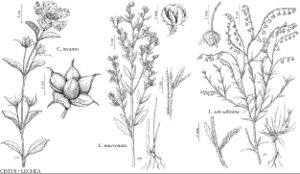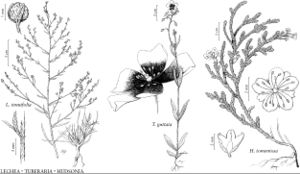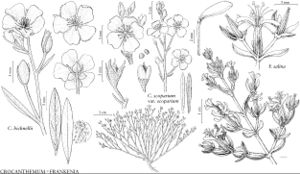Difference between revisions of "Cistaceae"
FNA>Volume Importer |
FNA>Volume Importer |
Revision as of 20:16, 24 September 2019
Herbs, annual or perennial, subshrubs, or shrubs, usually hairy. Leaves alternate, opposite, or whorled, usually estipulate, sometimes stipulate (Tuberaria), stipules caducous, petiolate or sessile; blade 1- or 3- [5-]veined from base, not lobed, sometimes scalelike, margins entire [crenate, serrate], sometimes revolute and/or undulate. Inflorescences usually corymbose, cymose, paniculate, racemose, thyrsiform, or umbellate, seldom solitary flowers. Pedicels present or absent; bracts present or absent. Flowers chasmogamous or cleistogamous; sepals persistent or tardily falling, 3–5; petals usually caducous [marcescent], usually 3–5, sometimes 0 in cleistogamous flowers, imbricate, distinct, crumpled in bud, green, dark red, pink, purple, red, white, or yellow; stamens (3–)5–150+; filaments distinct or basally connate; ovaries superior, 2-, 3-, 5-, or 6–12-carpellate; placentation parietal; styles 0 or 1; stigmas 1 or 3; ovules orthotropous [anatropous], bitegmic, crassinucellate. Fruits capsular, dehiscence loculicidal [septifragal]. Seeds (1–)3–800+ per capsule, often with thin outer integument.
Distribution
North America, Mexico, West Indies, Central America, South America, sw Europe, n Africa, mostly of temperate areas.
Discussion
Genera 8, species 170–180 (5 genera, 40 species in the flora).
Affinities of Cistaceae are evidently with Malvales. Members of Cistaceae are widely cultivated, especially cultivars of hybrids and species of Cistus, Crocanthemum, Halimium (Dunal) Spach, and Helianthemum Miller.
Hairs on Cistaceae plants may be simple or stellate (comprising tight clusters or tufts of simple, unbranched hairs) and glandular or eglandular.
Two species of Cistaceae have been collected in the flora area as waifs. Helianthemum nummularium Miller is known from Colorado, Missouri, and Oregon; it differs from species of Crocanthemum by the combination of glabrous abaxial surfaces of sepals and stellate-tomentose ovaries. Helianthemum salicifolium (Linnaeus) Miller is known from New York; it differs from species of Crocanthemum by its opposite leaves and erect, curved pedicels.
Selected References
Lower Taxa
Illustrations
Key
| 1 | Capsules 5–12-valved. | Cistus |
| 1 | Capsules 2–3-valved | > 2 |
| 2 | Petals 3, usually red, sometimes green. | Lechea |
| 2 | Petals usually 5, sometimes 0 in cleistogamous flowers, usually yellow, sometimes white | > 3 |
| 3 | Herbs, annual; leaves mostly opposite (basal sometimes in rosettes; distal sometimes alternate). | Tuberaria |
| 3 | Herbs, perennial, subshrubs, or shrubs; leaves alternate (basal sometimes in rosettes) | > 4 |
| 4 | Shrubs; leaf blades scalelike or acerose to subulate; inflorescences solitary flowers. | Hudsonia |
| 4 | Herbs or subshrubs; leaf blades not scalelike or acerose to subulate; inflorescences usually corymbs, cymes, panicles, racemes, thyrses, or umbels, seldom solitary flowers. | Crocanthemum |


